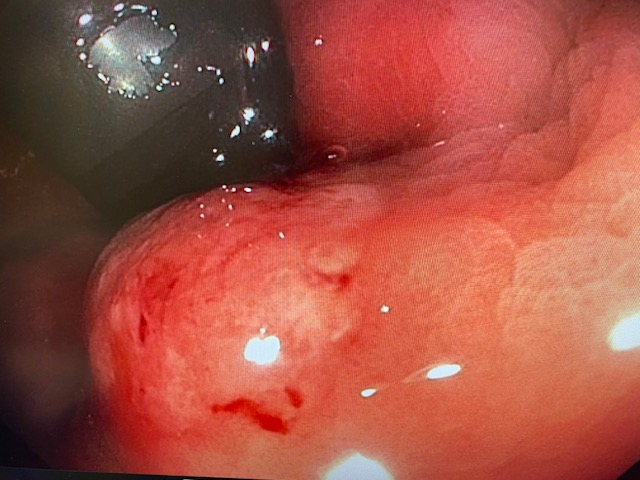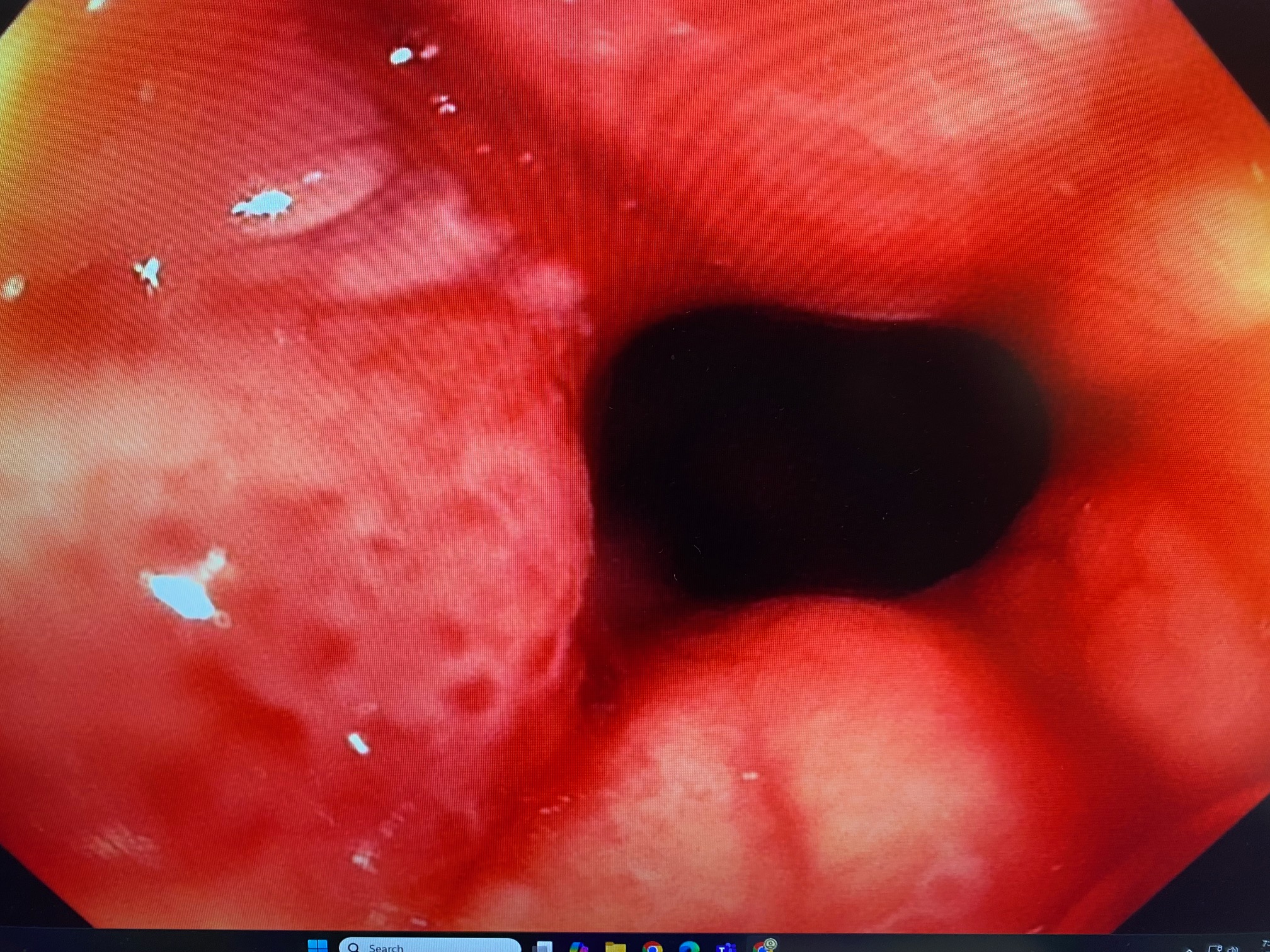Sunday Poster Session
Category: Colorectal Cancer Prevention
P0533 - Positive Fecal DNA Test Leads to Removal of a Dysplastic Cloacogenic Polyp: Great Pick-Up or Dumb Luck? What Is a Cloacogenic Polyp, and Exactly What Types of Dysplasia Are Fecal DNA Tests Designed to Detect?
Sunday, October 26, 2025
3:30 PM - 7:00 PM PDT
Location: Exhibit Hall

Schyler McBride, BS (he/him/his)
NYIT College of Osteopathic Medicine
Glen Cove, NY
Presenting Author(s)
Schyler McBride, BS1, Charles E.. McBride, M.D., MD2
1NYIT College of Osteopathic Medicine, Glen Head, NY; 2Virginia Gastroenterology and Hepatology, Inc., Burke, VA
Introduction: Fecal DNA testing has rapidly expanded as a tool for colon cancer screening. While designed to find colon cancer and polyps, patients that test positive are sometimes subsequently diagnosed with other cancers (pancreas, prostate, gastric, etc.). This study examines a case involving a positive fecal DNA test that resulted in finding a rare cloacogenic polyp (CP). We consider whether this finding was related to the fecal DNA test, or incidental, and review what fecal DNA tests are designed to identify.
Case Description/
Methods: A 67-year-old, asymptomatic female presented with a positive fecal DNA test and was referred for colonoscopy. Her medical history was significant for hypothyroidism (thyroxine) and hyperlipidemia (atorvastatin). Her colonoscopy revealed a sessile polypoid lesion at the distal rectum, extending past the dentate line into the anal canal. The lesion was biopsied, revealing a CP, indeterminate for dysplasia. The patient was referred for colorectal surgery, and a 1.5 x 1.2 x .4 cm irregular lesion was removed transanally. Pathology confirmed an inflammatory CP with low grade dysplasia.
Discussion: CPs are rare lesions (< 1:100,000 patients) arising from the transitional zone of the anorectal junction, often just above or in contact with the dentate line. CPs can be solitary or multiple, sometimes associated with serrated or adenomatous lesions. Being inflammatory, CPs are often found in patients with IBD, constipation, prolapse, and pelvic floor dysfunction. Histologically, one finds a tubulovillous growth pattern, irregular crypts displaced into the submucosa, and prominent fibromuscular stroma. The diagnosis of inflammatory CP is confirmed by the presence of squamous or transitional epithelium overlying the polyp. Rectal bleeding is the most common associated symptom, although 20% are asymptomatic. Due to the malignant potential, endoscopic or surgical removal and surveillance is recommended.
Fecal DNA testing examines 11 molecular markers, specifically targeting defects associated with colon cancer and advanced adenomas. The markers look for methylation errors (NDRG4 and BMP3 sites), DNA point mutations (targeting KRAS gene), and non-DNA-based hemoglobin assays. Fecal DNA testing is colon cancer/advanced adenoma-specific, looking for those genetic changes.
As CPs are not known to have such genetic alterations (unless the patient had occult bleeding that might detect hemoglobin), this case was likely an incidental finding unrelated to the positive fecal DNA test.

Figure: Cloacogenic Polyp, retroflexed view

Figure: Cloacogenic Polyp, anterograde view
Disclosures:
Schyler McBride indicated no relevant financial relationships.
Charles McBride, M.D. indicated no relevant financial relationships.
Schyler McBride, BS1, Charles E.. McBride, M.D., MD2. P0533 - Positive Fecal DNA Test Leads to Removal of a Dysplastic Cloacogenic Polyp: Great Pick-Up or Dumb Luck? What Is a Cloacogenic Polyp, and Exactly What Types of Dysplasia Are Fecal DNA Tests Designed to Detect?, ACG 2025 Annual Scientific Meeting Abstracts. Phoenix, AZ: American College of Gastroenterology.
1NYIT College of Osteopathic Medicine, Glen Head, NY; 2Virginia Gastroenterology and Hepatology, Inc., Burke, VA
Introduction: Fecal DNA testing has rapidly expanded as a tool for colon cancer screening. While designed to find colon cancer and polyps, patients that test positive are sometimes subsequently diagnosed with other cancers (pancreas, prostate, gastric, etc.). This study examines a case involving a positive fecal DNA test that resulted in finding a rare cloacogenic polyp (CP). We consider whether this finding was related to the fecal DNA test, or incidental, and review what fecal DNA tests are designed to identify.
Case Description/
Methods: A 67-year-old, asymptomatic female presented with a positive fecal DNA test and was referred for colonoscopy. Her medical history was significant for hypothyroidism (thyroxine) and hyperlipidemia (atorvastatin). Her colonoscopy revealed a sessile polypoid lesion at the distal rectum, extending past the dentate line into the anal canal. The lesion was biopsied, revealing a CP, indeterminate for dysplasia. The patient was referred for colorectal surgery, and a 1.5 x 1.2 x .4 cm irregular lesion was removed transanally. Pathology confirmed an inflammatory CP with low grade dysplasia.
Discussion: CPs are rare lesions (< 1:100,000 patients) arising from the transitional zone of the anorectal junction, often just above or in contact with the dentate line. CPs can be solitary or multiple, sometimes associated with serrated or adenomatous lesions. Being inflammatory, CPs are often found in patients with IBD, constipation, prolapse, and pelvic floor dysfunction. Histologically, one finds a tubulovillous growth pattern, irregular crypts displaced into the submucosa, and prominent fibromuscular stroma. The diagnosis of inflammatory CP is confirmed by the presence of squamous or transitional epithelium overlying the polyp. Rectal bleeding is the most common associated symptom, although 20% are asymptomatic. Due to the malignant potential, endoscopic or surgical removal and surveillance is recommended.
Fecal DNA testing examines 11 molecular markers, specifically targeting defects associated with colon cancer and advanced adenomas. The markers look for methylation errors (NDRG4 and BMP3 sites), DNA point mutations (targeting KRAS gene), and non-DNA-based hemoglobin assays. Fecal DNA testing is colon cancer/advanced adenoma-specific, looking for those genetic changes.
As CPs are not known to have such genetic alterations (unless the patient had occult bleeding that might detect hemoglobin), this case was likely an incidental finding unrelated to the positive fecal DNA test.

Figure: Cloacogenic Polyp, retroflexed view

Figure: Cloacogenic Polyp, anterograde view
Disclosures:
Schyler McBride indicated no relevant financial relationships.
Charles McBride, M.D. indicated no relevant financial relationships.
Schyler McBride, BS1, Charles E.. McBride, M.D., MD2. P0533 - Positive Fecal DNA Test Leads to Removal of a Dysplastic Cloacogenic Polyp: Great Pick-Up or Dumb Luck? What Is a Cloacogenic Polyp, and Exactly What Types of Dysplasia Are Fecal DNA Tests Designed to Detect?, ACG 2025 Annual Scientific Meeting Abstracts. Phoenix, AZ: American College of Gastroenterology.
